You must be logged in to rate content!
17 minute read
504 Ti engine with full engine management
Compliments of Stewart @ http://www.505turbo.com
6-25-2013
This is a little of what's going on in my shed. A 505 2l injection head being used with a 0.5mm overbored 2l XN 2 engine.
Target static compression 11:1.
Engine is 0.5mm over bore running ACL pistons . Nissan SR20 CAS where the distributor should be and 306 wasted spark coil pack. Throttle bodies, closed loop wide band and knock sensitive ECU.
It is running a quite aggressive lift profile and lobe centre line on the cam. The new Valve springs will see it safe to 7000 rpm without bounce. Rev limit is at 6700 and hopefully if my mathematics are close, a flexible engine with a boot in the arse from 2500 to max power at 6500.
There's a long way to go yet but, we have runs on the board with a lesser engine, running distributor and 2 x 40mm Webers, giving us 160hp.
With some careful tuning, perhaps the well balanced, Historic Rally 404 it's going into, will help steal some silverware from the 1600 Datsuns that win everything.
I hope as the thread continues it proves of interest to my fellow Peugeotphiles!
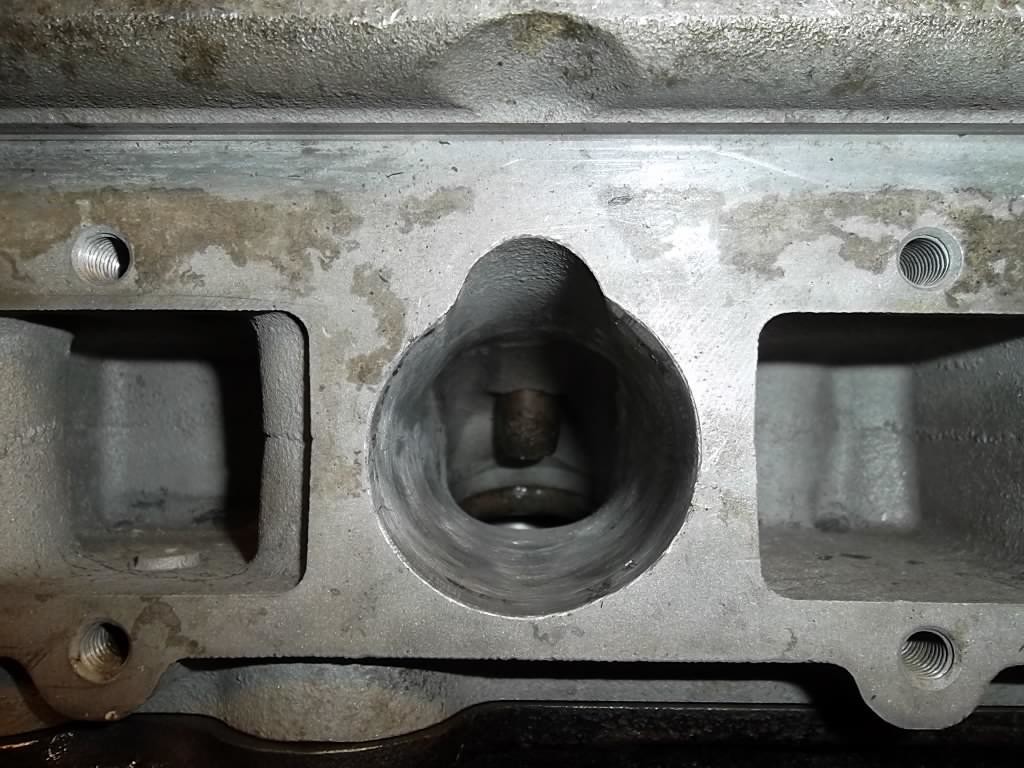
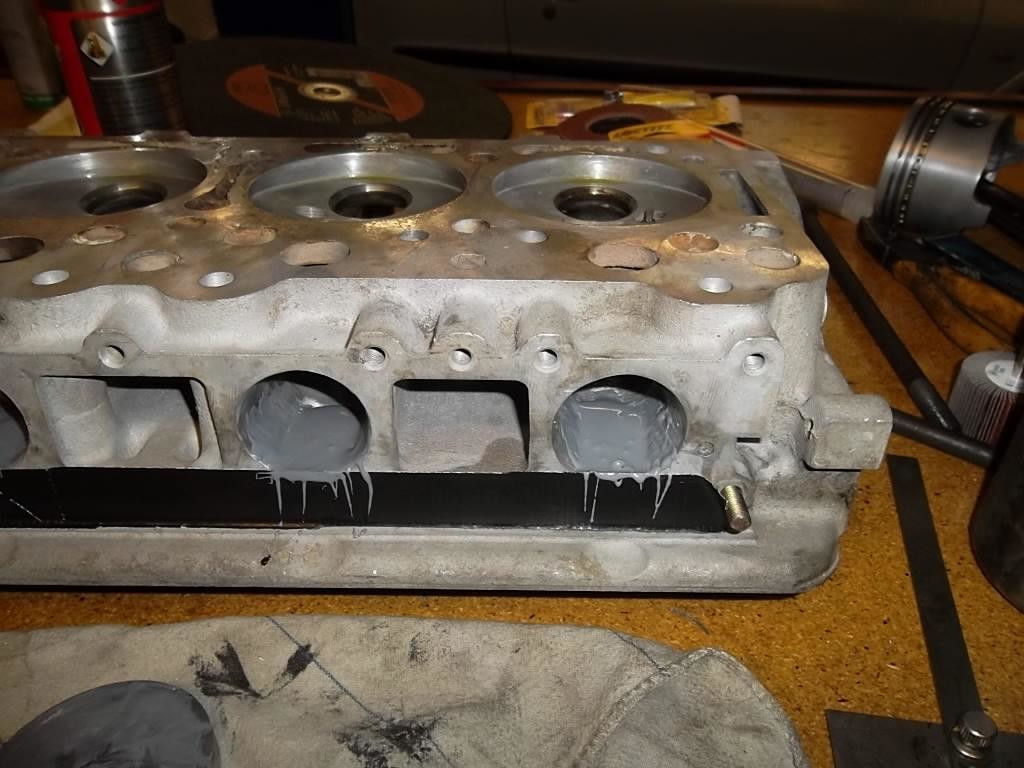
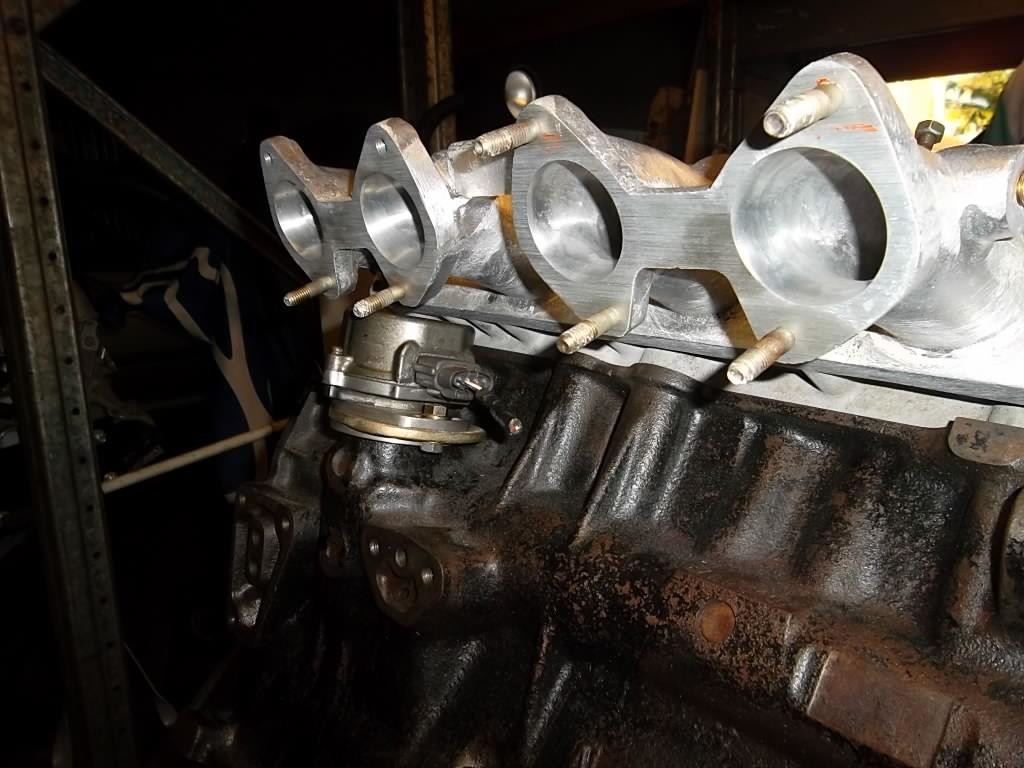
6-26-2013
I'll get the numbers for sure Mike!
Rabin,
The story this time is I'm filling the old injector rebate as the new stuff injects at the throttle body and I want to get the port into the complete funnel/tunnel shape to give the sound wave a lovely smooth ride through the duct. I did plenty of sypherin' with this and found the Ti port , on this head anyway, goes from 42 to 39 or so the first 30mm in and the seat inner diameter is 36.4 so this is one of the famous tapered inlet design whispered about in scientific calculations of Yore.
I started work on the geometry of the rockers last night and now with a small increase in pushrod length ( how I do this I haven't decided) the geometry ( thanks to Jim Miller's Book) will be beautiful. A challenge, as the head has been machined, the block as well and the cam has had 2mm off it's base circle. Man this thing is going to sound sweeeet.
7-9-2013
Things are moving along well. It needed longer and stronger pushrods for the cam lift and machined head and block. Chromoly 3/8" tube and the Pug ends did the trick. I made up a jig to hold the sleeves in the lathe to machine off the seat for the correct sleeve height for the decked block. All done and set at +0.005", 0.12mm.
7-10-2013
No liner seal, Loctite, metal to metal. I left the camera at my 2nd hand Porno, Beta DVD only, ebay shop, and the internet is not good at the moment, so no new naughty images from me tonight.
.
I plucked up the courage to give the 404 a try with the Link G3's Auto tune feature and, to turn that on while driving parts to a machine shop on Monday. It is a wonderful and quick method. Being a Peugeot and with a Link finding someone interested to run the thing on the dyno in town here is difficult. The best people are 600 kms away . Soon I will get the figures. I'm going to creep up on the fine tuning over the next 2 weeks myself. I've fitted the Innovate LM-2 to the dash and am using that to log into the Link which will do the Auto tune for me, whenever time permits.
Can you believe the engine will go stoichiometric during warm up driving? A little more effort yet for me and I'll just go and get the thing measured. The boost is set at a max of 0.7 bar and the ecu is tuning to it. I'll step the boost control pulse up and auto tune each 10 kpa extra, until 1.0 bar or so then go the dyno to get an unboosted and a reasonable street boost, torque number.
Bare with me as I'm also wrenching in my own business without help on the floor, so this takes a lot of effort. I need to do it though!
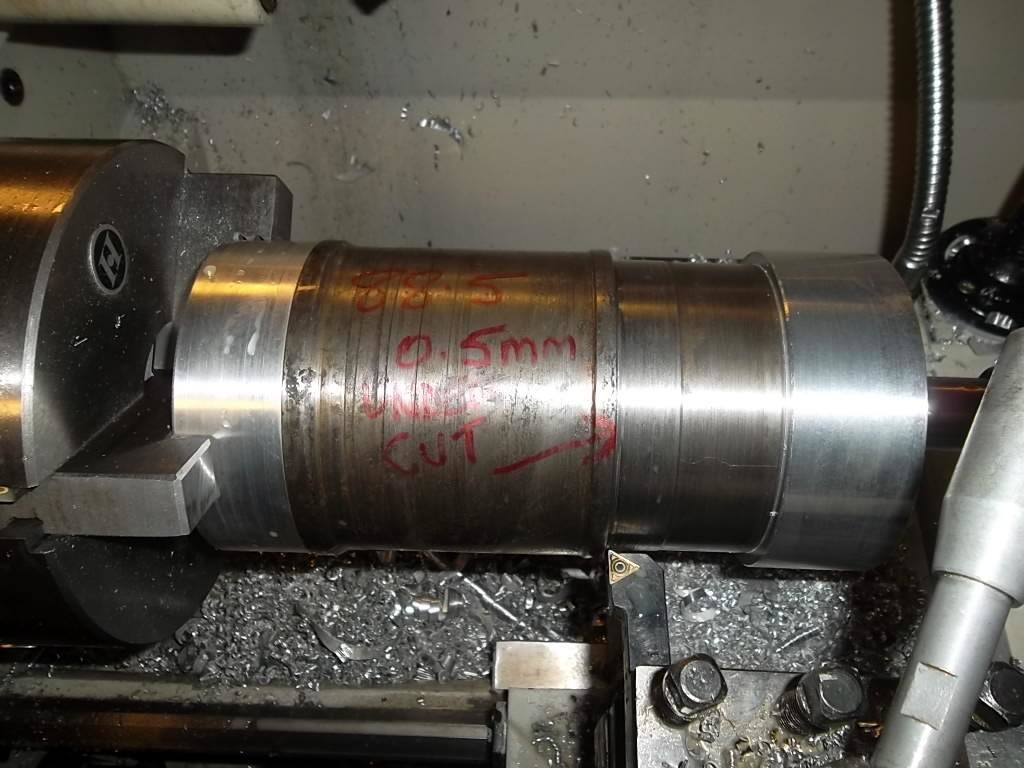
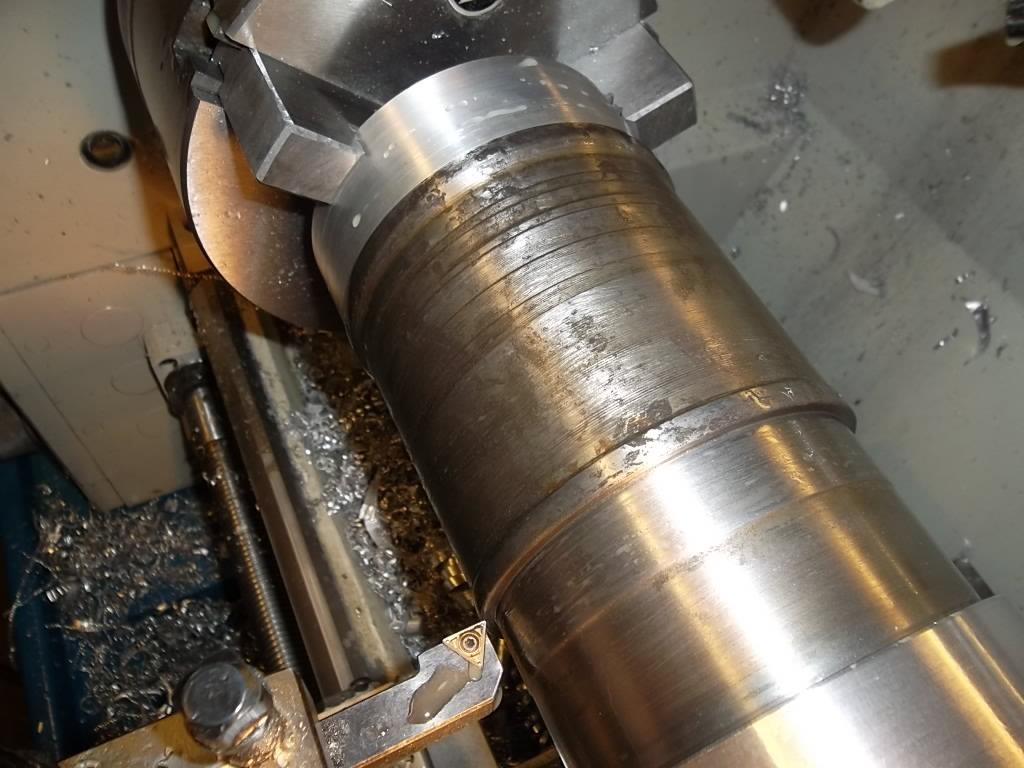
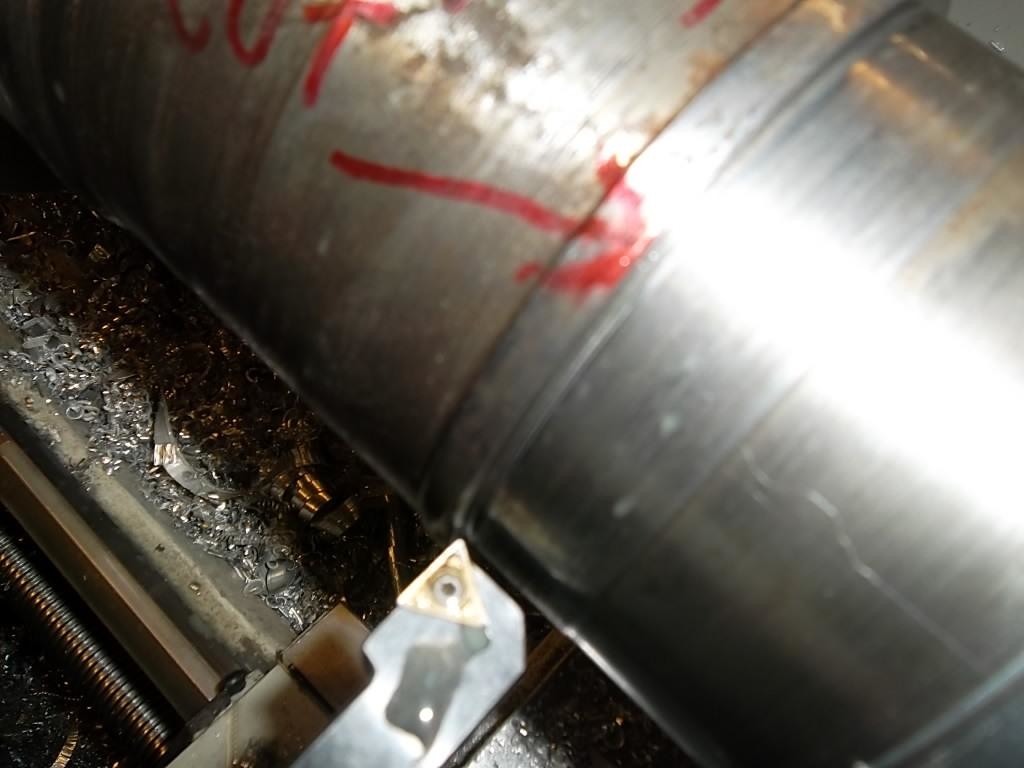
510 Loctite is the sealer de Jour! Engine crankcase breathing control, has always been an issue with these things too. The Ti's and SLi's with the K jet, were pretty clever as they vented back into the oil bath air filter. The system I'm making up takes any gaseous vapour from the old oil filler on the block to a can where any breather oil can return to the sump. Makes sense so far, anyway. Looks pretty good too. Burton Power have a great site and this link helps with explaining my ravings.
http://www.burtonpower.com/tuning-guides/tuning-guide-pages/engine-breather-system.html
Got me thinking!
7-11-2013
Here are a few of the progress. Inlet port with epoxy filler and manifold matched.
Pushrod in chromoly and a sample of the type of contact you can get on the valve as rocker height and pushrod length get changed to suit new lift or machining. It all adds to a big reduction in sideways forces through the valve action and reduces friction, of course. Looking pretty promising!

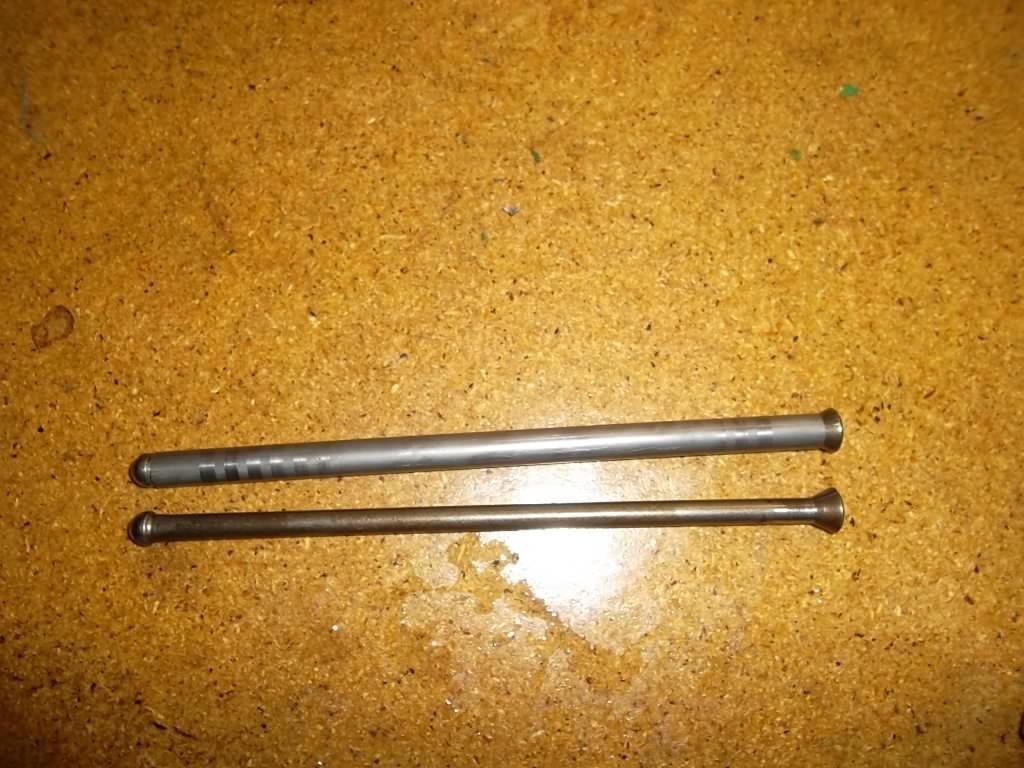

7-18-2013
More progress, Chaps!
And almost buttoned up. There are a few more items to tackle, though. The rockers are pushing up into the valve cover. ( As expected, but it's the exhausts not the inlets !) .
As you can see we made up a "windage" plate in an attempt to control the oil spray and to reduce the effect it has on the sump oil. Very important to control blow by and crank fumes. As Bean pointed out, the Provent 200 has got to be the best thing yet, for our oddball gear.
Second is the new inlet port without the injector cutting. This head is circa 86/ 87 and has a superb tapered port design. I haven't measured the old '74 head I have here, I suspect it will have the same dimensions in the inlet port, as it runs the same size valve and seat.
Third is of the chromoly pushrods and the larger drillings in the head, for them to operate in.
Forth has a reasonable view of the transformation. The yellow parts are electroplated using a small kit I have here, by Caswell.
Next, will be winding up some oil pressure by hand, to double check oil delivery to rocker gear and get a feel for the oil tolerances, the Nissan CAS goes in next, using the original Pug dist drive, provided the oil pump test feels good.
I hope this proves interesting.
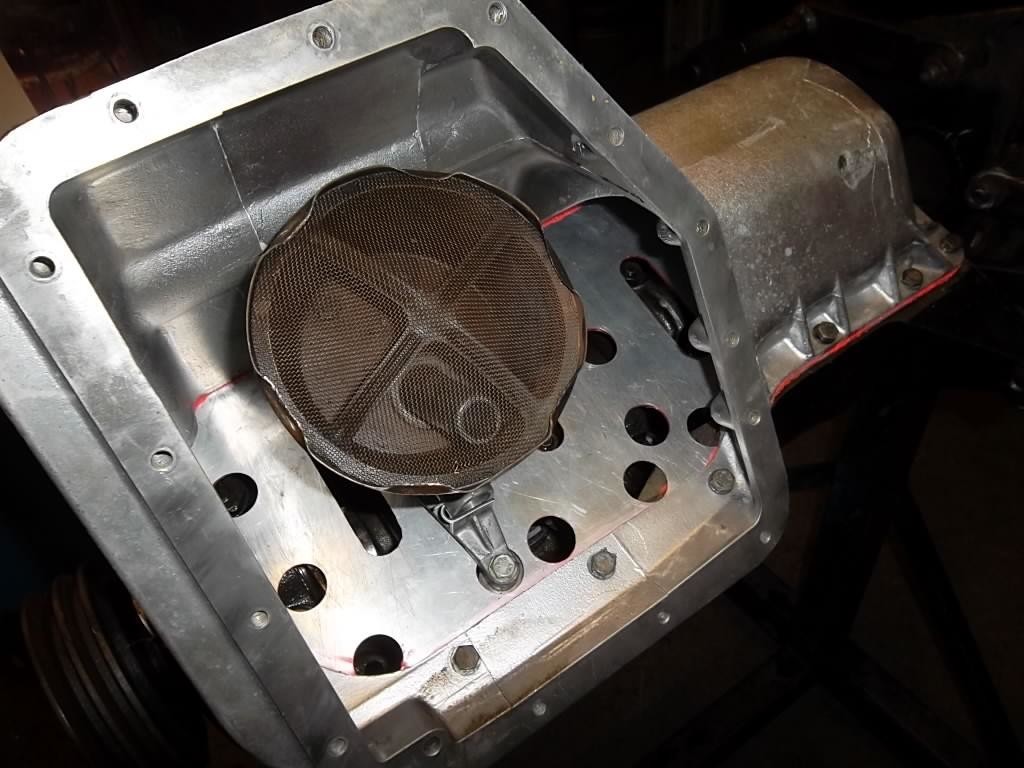
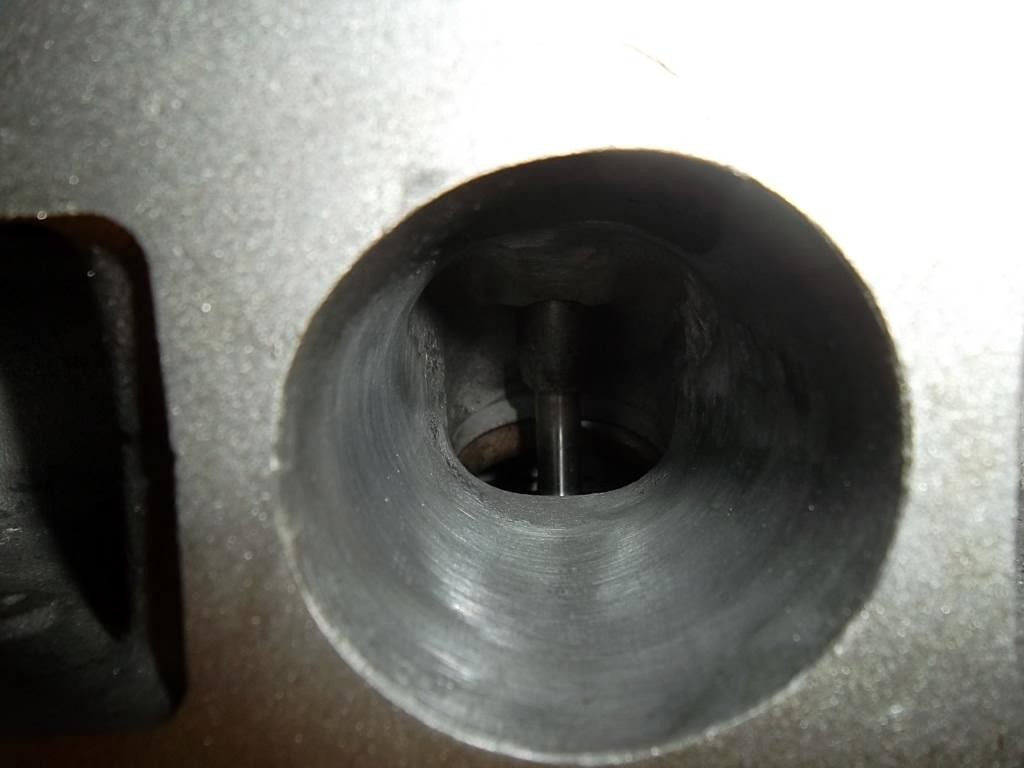
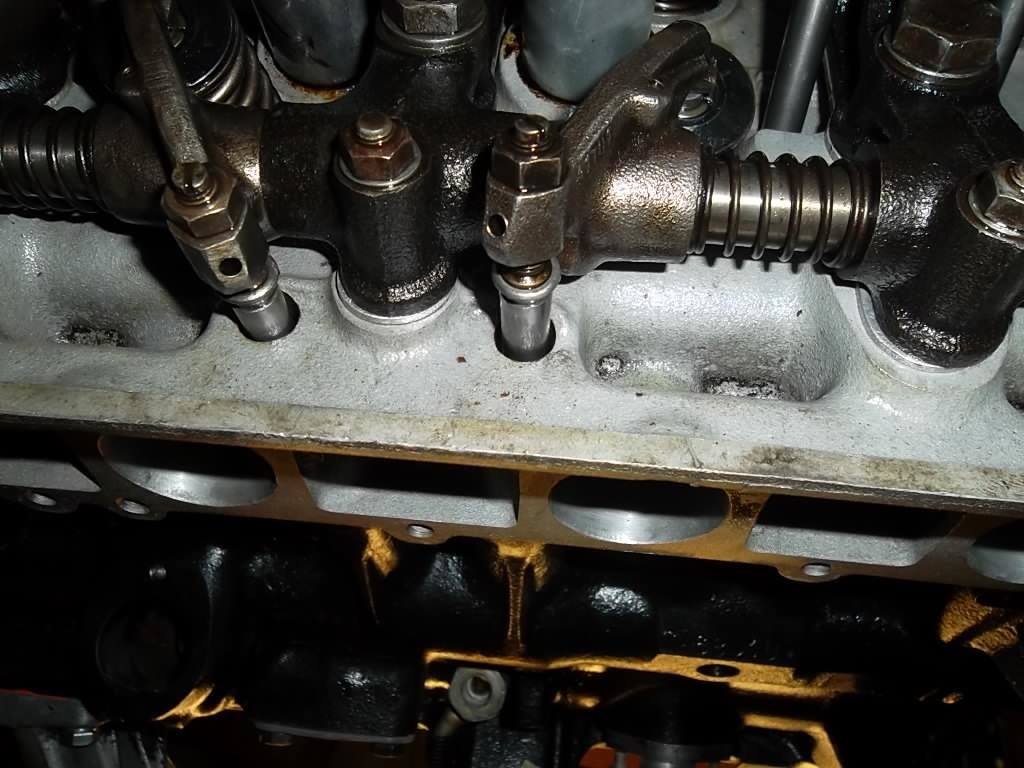
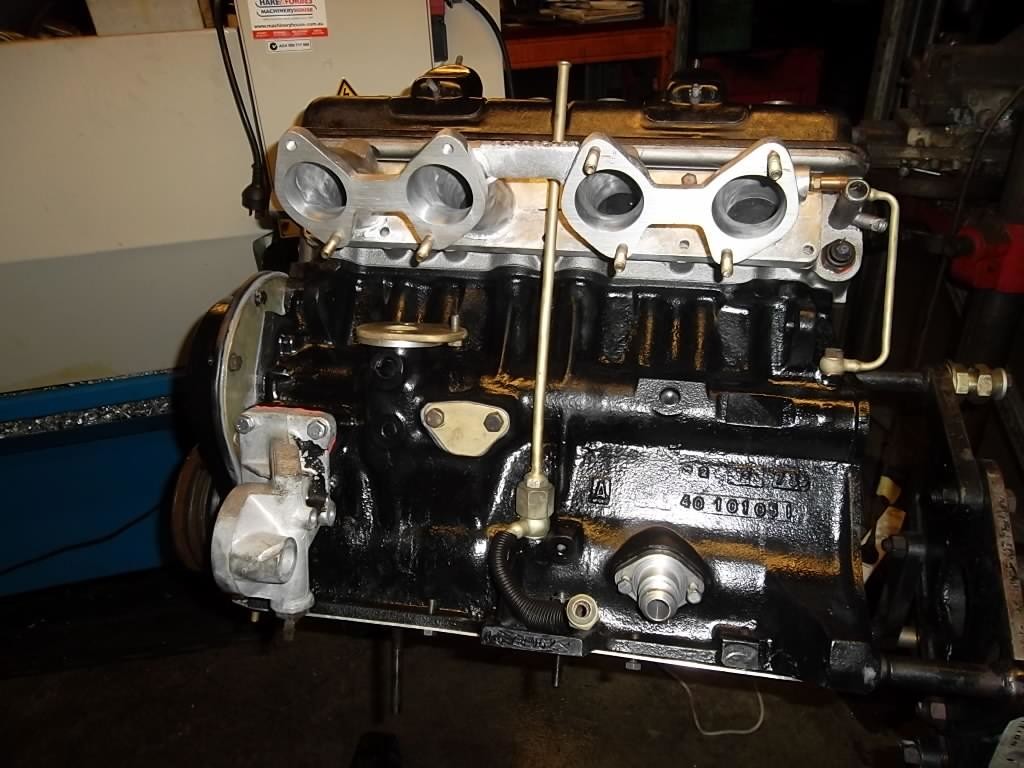
7-20-2013
Bean, Have you ever seen or thought about a Load Test Bench to run up engines on? It would great to run an engine and load it at various revs and throttle to get a base tune as well as run the thing in. An Engine dyne is over my budget but, a frame, a radiator and something to brake the engine would prove pretty interesting!
My initial thoughts are some sort of hydraulic pump, or a truck brake disc and caliper and a wind on tap for pressure.
Have you run across a similar backyard lunatic idea?
Thanks for the reply, Rabin. I now think I have the makings of something floating around at the workshop.
Picture this, Hook up an auto box to the engine.( I have a rebuilt one anyway, up in storage). Set up a tailshaft with several discs attached. Brake those discs one , two, three or four to load the torque convertor and that gives the option then of selecting what gear the box could be in so a small amount of brake could be applied in top gear at whatever rev. That assembly would give a flywheel effect, slightly loaded for the run in and cruise. Open the throttle against the braked auto and run through the tune.
My initial thoughts are if it was to be a different engine use that cars auto on the bed set up.
Is this clear thinking?
7-21-2013
I found a site where a Retarder from a truck is used. Hydraulic action like a torque convertor but the outer body is stationary.
If you listen carefully he is walking around in what we call "thongs". Australia's preferred, Taiwanese safety boot! I believe he is a Black Sabbath fan too! Guess what I'm going looking for tomorrow?
7-24-2013
Yes, that's what I'm thinking. I thought about the other side of the small old car engine industry here, today. Getting to run an ancient, rebuilt engine in, on a test bed is the best way to iron out the old machinery before the big job of fitting it . But after all that effort a torque number, before and after, is something to consider. Then again, there is a spare auto up in the mezzanine floor I haven't used. That with a brake on the output is looking pretty easy.
7-30-2013
Right Ho!
I've learned and re remembered a bit more since the last post. I'm thinking a gear type hydraulic pump to provide resistance.
It will have to be geared down from the engine, I think a 505 diff will do, about 3.7:1 ratio.
Still tracking down a suitable capacity unit but here is an example of where the ideas are coming from.
http://www.internationaldyno.com/products.html
8-19-2013
The engine is about finalised in assembly now. You can see the sleeve sitting in the block with a pink sealer around the base. No sleeve seal. The liner shoulders were machined to suit the decked block for a 0.005" protrusion. Block was decked 0.020" which gave us 0.020" positive deck height with this piston.
Notice the head dowell fitted as well. Final static compression is 10:1 with 88.5mm pistons and no flycuts in the piston crown needed for valve to piston clearance.
0.037" between piston and valve at TDC with valve open 0.077" on cold clearance settings. Gapless second rings as well.
The new valve springs are 80% more seat load than the poor old worn out Pug units. 40% more than the new spring, factory spec.

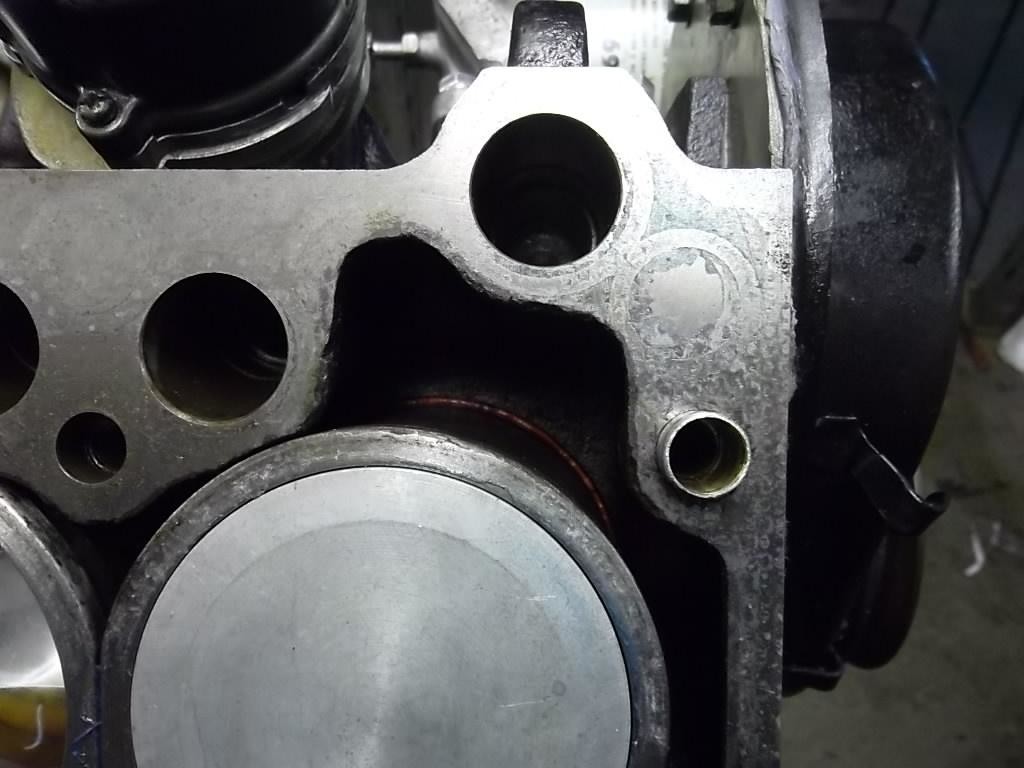
10-21-2017
I had better update this as it seems some people are interested in the project. I managed to achieve the finished build and run it up on an engine testbed I made. We had knock control, data logging on board, wasted spark, 4 x 45mm throttles and some beautiful noises from the engine at wide open throttle.
I managed to run it up to 4500rpm wot and measure torque at 150 lb ft. It overwhelmed my test gear then! Some data also coincided extremely close with the Dynosim 5 software once I tuned the mixtures. 12.5 : 1 AF with 10.03: 1 CR at ignition point of 35 deg, no knocking on ulp. Image belows compares in light colour the predicted ignition and torque with the actual ignition I ran at 4500 rpm and a prediction in dark red of the torque I might expect using complex mathematics. I measured 150 lb ft. that afternoon. Amazing! If anyone is interested on the methods I used to scratch tune this I can post up the details . 150 lb ft equates to 128 hp at 4500 rpm. The std Ti had 110 hp ( advertised) at 5600 rpm. I have another build on at the moment which will have Webers and a programmable distributor instead. I have the maps in my laptop and hard drive for reference.
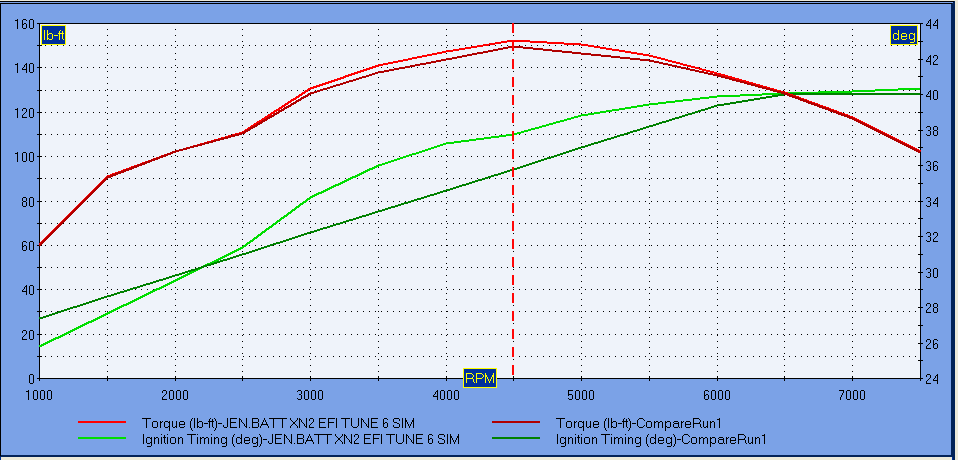
10-22-2017
Some images of the build and test bed I knocked up for initial scratch mapping. I had a lab power source hooked up and then tuned dwell and injector deadtime down to almost 6 volts up to 15 volts. That made the engine start beautifully. The white graph is the tuned in ignition map, TPS to RPM. The blue blue graph is Dynosim 5 ignition figures for use in the Simulation. You can see the ECU at WOT and 4250 to 4750 35 and 36 degrees respectively. No knocking recorded or heard via electronic stethoscope. Also recorded on a digital strain gauge 150 lb ft at 4500 at 12.5 af ratio. Simulator worked . I had no alternator fitted but did use the water pump in the test. You can see my custom valve springs and retainers , chrome moly pushrods, and aren't those blue trumpets cool? Valve lift is 0.440" . 275 seat to seat and 231 at 0.050". I made a cover to blanket the alloy inlet runners which keeps the inlet at 50 to 60 in the manifold. I used a Hitachi Optical CAS from a nissan it sits tightly under the manifold where the distributor was. Wasted spark from Subaru Liberty with coil dumb coil drivers inside coil pack. Mi 16 injectors. Coolant temp fitted under thermostat in water pump from 505/306/405 CTS and air temp from 306 throttle body. I fitted a fuel tank purge valve as the fast idle air inlet which was pulsed by ECU and closed at 50 C. Engine is patiently waiting at owners shed to fitted to a rally preped 404 . 4 wheel disc brakes, hypoid diff, BA7/5 gearbox. I also made up a replacement driveshaft for a couple of his cars using 505 shafts from a wagon. We fit a solid crucifix uni from a small ford into a 505 uni and use the 505 splines on our shortened tailshaft. I break unis easily in my 404 and this idea seems to be working pretty well at the moment.
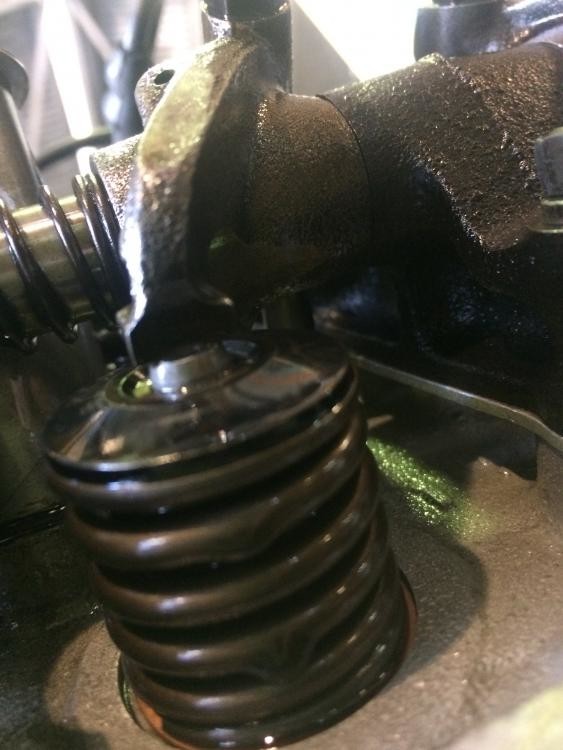
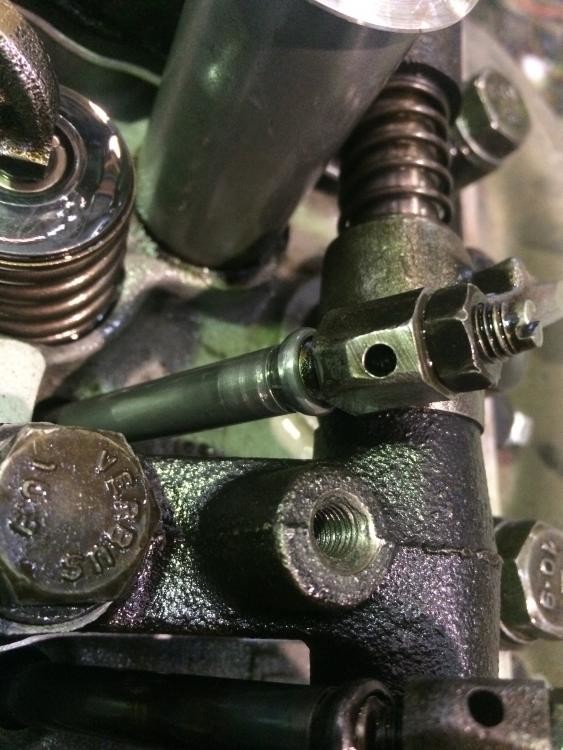

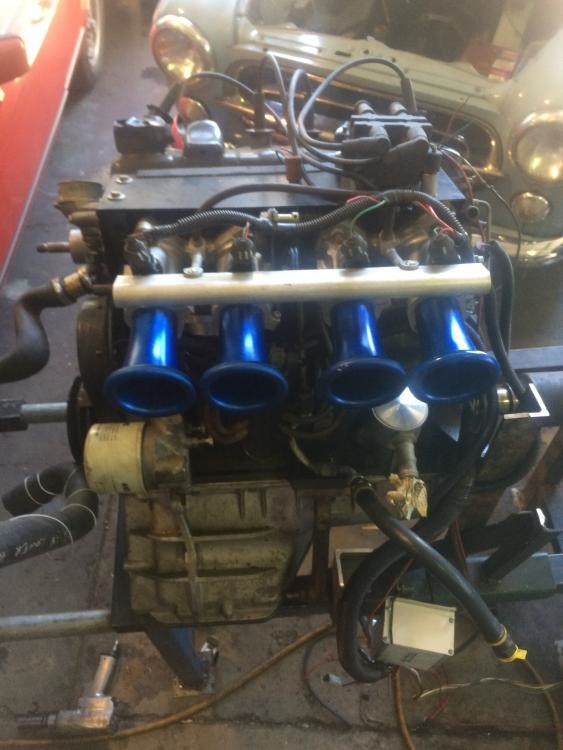
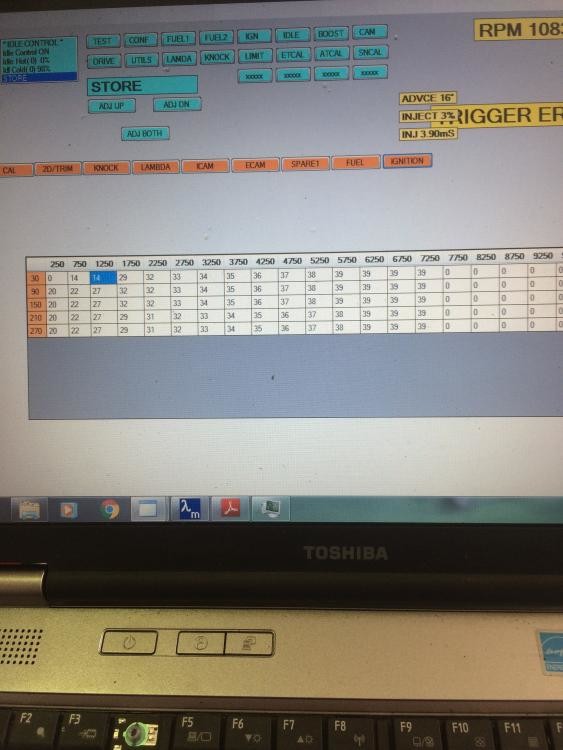
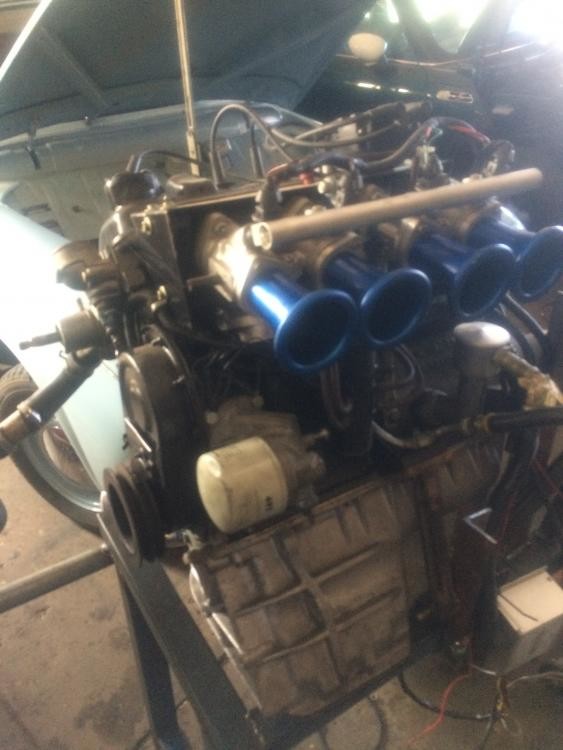
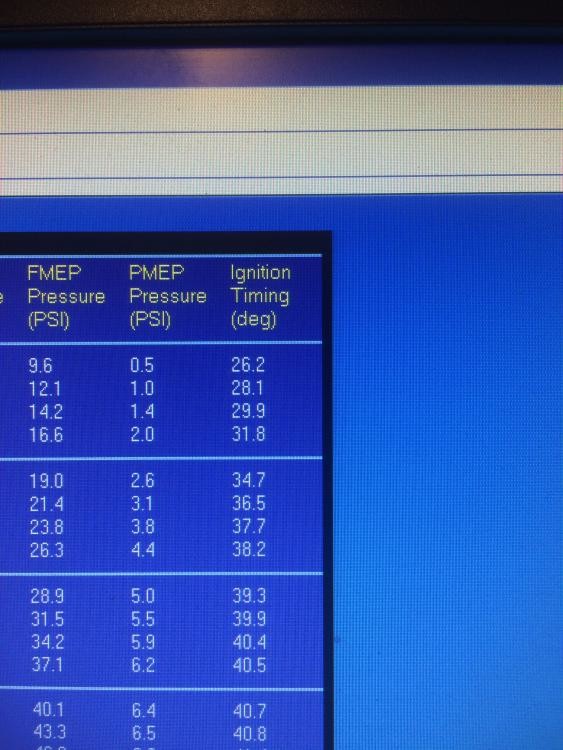
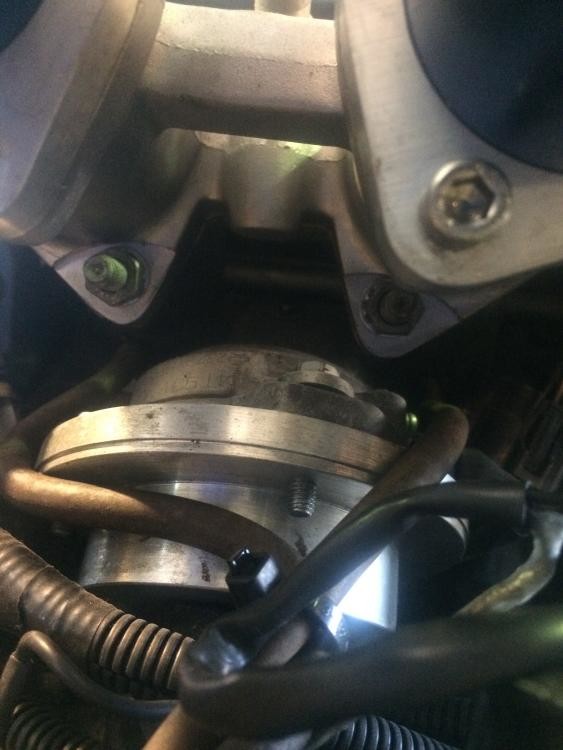
2-23-2018
I ended up running the engine on the test bed to 4500 rpm, wide open throttle and fully loaded. It returned 145 lb at 4500 at predicted ignition of 37 deg. BTDC.

2-24-2018
Sorry. RPM . Here it is again. It has 4 x 45mm throttles, 2x 2 batch fired injectors and wasted spark. My exhaust was the larger bore factory manifold and a not so pretty large pipe into an old Landcruiser muffler, so there is probably more left. All things considered , until 4500 rpm WOT the prediction matched my torque readings withing a few lb. Air temps were high at 55 to 60 deg C.
Engine needs to run in too. I'm very happy with it. A sound so glorious that men from the neighbourhood just wanted to sit in the door and listen! I purchased Pipemax a while ago so the next version of this engine should be a little better. The inlet ports were filled where the injector relief was and just gently finished . The exhaust ports got a lot of material removed though. A little rally 404 sedan should boogie with it.
If you check the second image the torque I measured at 4500 rpm was 145 lb, with the prediction saying 150. With exhaust system fitted there is every chance of the predicted at power at 6500 rpm.
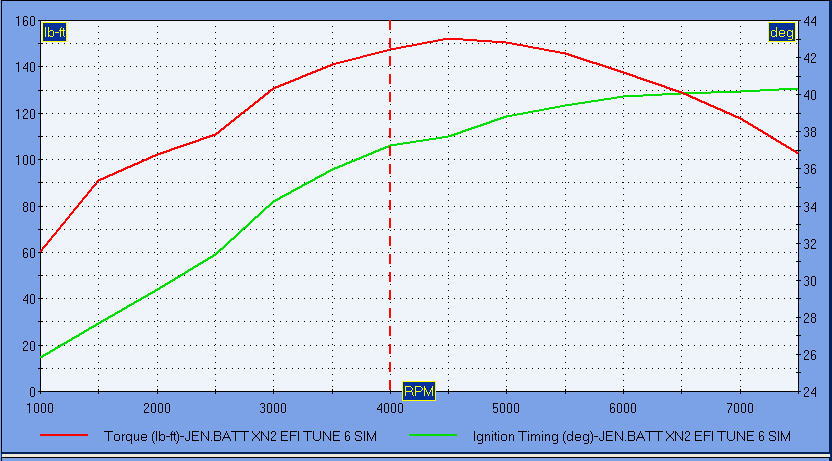
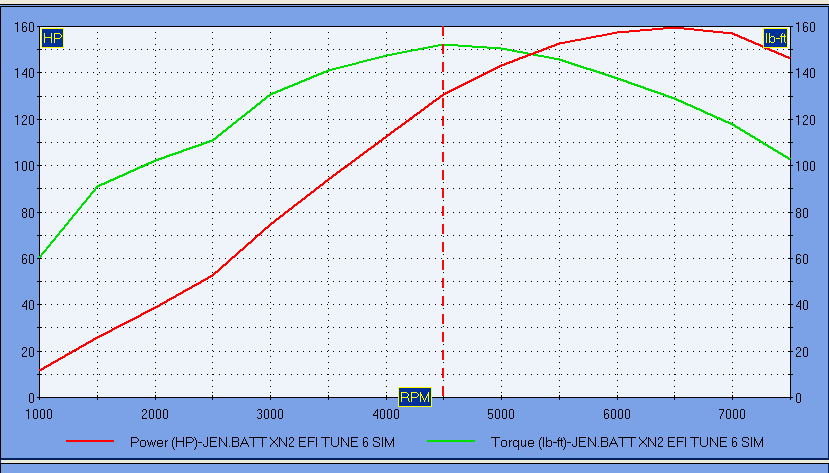
G'Day Drew, I'm using standard valves. I have another getting built up with more fine tuning in the port dimensions and valve head shape.
This cam is a product of Owen W ( aussiefrogs) and Camtech. 622/107. Your cam is one of my set ups ground by Tighe Cams. for street use. The 622/107 by Camtech is a nice set up which is almost a Tighe 240 with a little more lift.
Your cam is Intake 19/58 0.455" lift Exhaust 70/21 0.474" lift, long inlet and plenum. The throttle body engine is Intake 30.5/64.5 0.444" lift Exhaust 66.5/28.5 0.444" lift and 4 x 45 mm throttles. I have a heat shield over the top of the inlet manifold to keep the runners hot as well.
Below in red and green is what I think would be your engine compared to in the dark red and dark green the tested engine I got tuned to 4500rpm with the predictions very close to reality. You can see how much more low rpm your set up has here.


